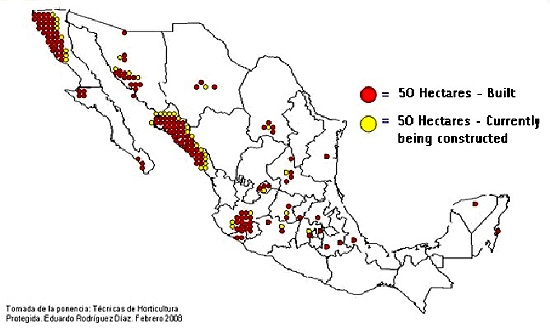The commercial greenhouse production of horticultural crops in Mexico started in the 1950s, with floriculture (flower-growing) operations. It then expanded to include some vegetables in the 1980s. During the 1990s, larger, more modern greenhouses were introduced specializing in the growing of vegetables for export markets.
In 1991, Mexico had only 51 hectares of vegetable production in greenhouses. The signing of NAFTA in 1994 stimulated increased investment in Mexico from Israel, Holland, and Spain in greenhouse systems designed to boost vegetable production for the US market.
The area of greenhouses has risen rapidly since then to about 2,400 hectares in 2009, almost double the area recorded for 2005, and including 1,000 hectares devoted to flowers.
What are the advantages of production using greenhouses?
- possible to control the environment
- enables a higher quality of product, suitable for international markets
- improves food safety
- allows growers to have a tighter control on water quality
- enables farmers to supply winter markets when fresh food prices are at a premium
- avoids or offsets weather-related problems, such as cold spells or heavy rain
- allows farmers to perfect crop timing to match times of highest prices
- avoids some open-field issues such as weeds and insect pests
- takes advantage of Mexico’s long days and many hours of strong sunlight
What are the disadvantages of production using greenhouses?
- construction costs
- costs to install necessary infrastructure, such as water supply
- cost of energy required to heat greenhouse in the event that sunshine is insufficient
- nearby residents may object to the unsightly view of hectares of greenhouses

Protected agricultural areas in Mexico (greenhouses and shade houses), 2007. Source: Mexican Association of Protected Horticulture
Where are most of Mexico’s greenhouses located?
Vegetable greenhouse production is highly developed in five states (see map):
- Sinaloa (26.3% of Mexico’s total production of greenhouse vegetables)
- Baja California Sur (13.5%) -NB this state’s protected area has increased sharply since 2007, the date of the map
- Baja California (9.5%)
- Jalisco (7.4%)
- Sonora (6.9%).
Combined, these five represent 84% of the total greenhouse production of vegetables.
By area planted, the major crops produced in greenhouses in Mexico are:
- tomatoes (60% of the total)
- cucumbers (20%)
- chiles (10%)
One clear trend is that the area of all these crops is expanding very rapidly. For instance, from 2007 to 2008, the area devoted to the greenhouse production of tomatoes rose 19%, while chiles and cucumbers rose 35% and 29% respectively.
95% of Mexico’s greenhouses are plastic, rather than glass, mainly because the extra insulation afforded by glass is not required in most parts of Mexico given the climate. Many greenhouses are now made in Mexico, but others are imported from Israel, Canada, the Netherlands, Spain, France and the USA. Many of the greenhouses are high-roofed, between 4 and 5 meters tall.
A basic greenhouse structure covering 1 hectare (2.4 acres) costs about $160,000, excluding the cost of any irrigation system. Because financing is difficult to obtain in Mexico, many producers rely on relatively low-cost plastic greenhouses, which do not usually have any heating systems. Some newer models have hot water or gas heating systems which guarantee that crops can be timed to coincide with peak demand during the US winter.
In an effort to hasten the adoption of improved horticultural technology, the Agriculture Secretariat (SAGARPA) has started a shared-risk fund to encourage greenhouse installation, provided it is to grow crops other than tomatoes, including herbs, chiles and lettuce.
Besides initial costs, another major constraint on the expansion of greenhouse systems in Mexico is distance from the main markets north of the border. From some areas, reaching markets in California requires a 36-hour truck ride. Any delay means that the crop will not arrive in optimum condition.
Another limitation which restricts the universal adoption of greenhouses is that they generally need a good supply of water. This is not always easy (or cheap) to obtain, especially in arid areas such as Baja California.
Finally, as with most farmers, greenhouse operators in Mexico face competition from growers in other countries, and also have to contend with market volatility (whether real or perceived).
Sources:
Lopez, J. and K. Shwedel. 2001. The Mexican greenhouse vegetable industry. Industry Note 032-2001, 5 pp.
Cantliffe, D and Vansickle, J. Mexican Competition: Now from the Greenhouse. http://hos.ufl.edu/protectedag/pdf/MexicanGHindustry.pdf [accessed 22 January 2011]
Flores, D and Ford, M. Greenhouse and Shade House Production to Continue Increasing. USDA GAIN report, 22 April 2010. [accessed via link at http://www.freshplaza.com/news_detail.asp?id=62580; accessed 27 January 2011]
6 Responses to “The commercial greenhouse production of horticultural crops in Mexico”
Sorry, the comment form is closed at this time.
I have invented an irrigation system which doen not reguire R/O, that recaptures, and circulates water, which is totally organic. I use air to cavitate water vertically. It is not an air lift system. It uses a completely different technology. With minimal air pressure I have created a organic feeding, pumping, and filtering system, of which the world has never discovered. For three years I have been involved in intense R&D and I it is ready for commercial use.
Thanks for interesting comment; let’s hope some “commercial” entrepreneur reads this post and follows up with you and your valuable ideas. Tony
Did John Stone ever produce his organic irrigation system mentioned above? I’d like to see it.
Thanks for your interest in Geo-mexico. I´m not sure, but will post again here if/when I have any further information.
I appreciate your article. I stumbled upon it while looking for GH manufacturers in MX.
Thank you.
Thanks for the article. I came from a place prone to floods. My innovation is to introduce greenhouse farming to the region. My main setback is lack of funds and i request for assistance.